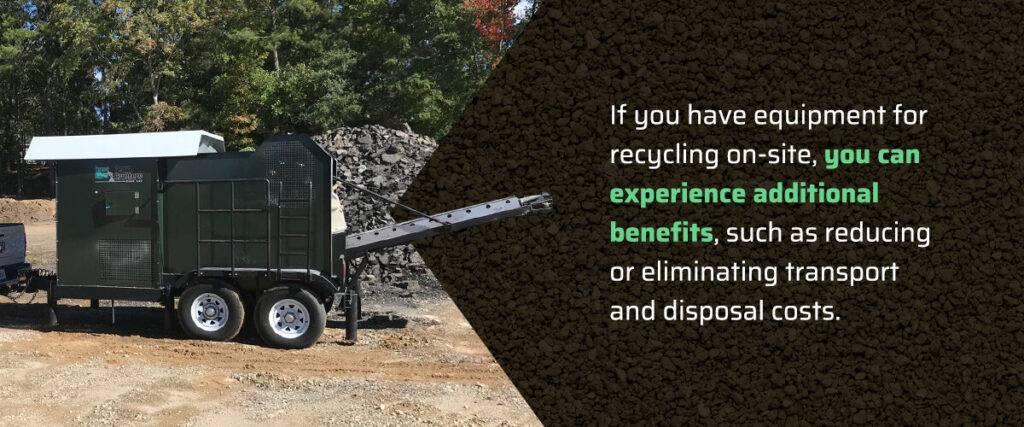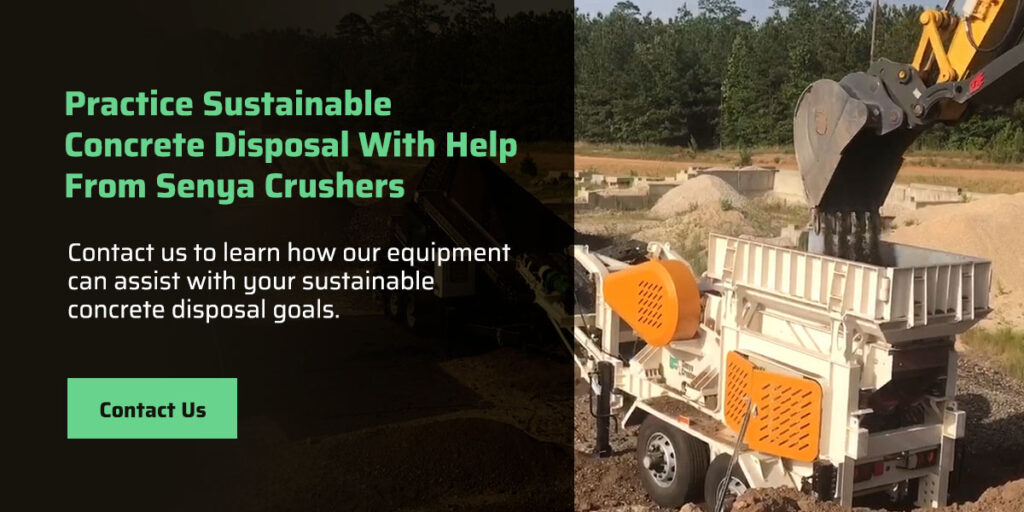
As industries throughout the world become more environmentally conscious, businesses need to find sustainability solutions that protect the environment and work for their operations. Within the construction industry, responsible concrete disposal is a critical component to sustainable construction practices that preserve resources while maximizing profits.
Staying up-to-date on emerging trends in concrete disposal can help you develop an effective, eco-friendly management plan that meets stringent certification and regulatory requirements. Following the latest sustainability practices also allows you to use your resources more effectively, resulting in better cost savings for your organization.
Future Innovations in Concrete Disposal
One significant trend in concrete disposal is a greater focus on sustainability. Circular economy practices encourage companies to recycle and reuse existing materials for as long as possible to maximize the material life span and minimize waste. Within the construction industry, companies are prioritizing resource efficiency to streamline operations, improve cost savings and manage their environmental stewardship.
With advancing recycling technologies, construction companies can use innovative crushing methods to improve concrete disposal management for better sustainability and disposal management. These new recycling methods give old concrete a second life, enabling companies to conserve natural resources and cut down on landfill use.
The development of new construction techniques and materials is helping to generate less concrete waste and decrease the need for and expenses of disposal. Through concrete recycling and reuse, companies are discovering alternative uses for their concrete waste, such as in road construction and landscaping.
Current Concrete Disposal Methods
Most construction companies use one of the following disposal methods to get rid of excess concrete during or after a project:
- Landfilling: Dumping concrete in a landfill is a common disposal method. It is easy to do, but the practice poses some environmental risks and can lead to high transportation and disposal costs.
- Recycling: To recycle concrete, companies crush the material to produce a new substance. These smaller concrete pieces form an aggregate that can be used for a variety of new construction projects.
- Reusing: If the concrete is in good condition, a company can use the material in its original form with minimal processing. Old concrete can be reused for a range of applications, from backfilling to landscaping.
Concrete Disposal’s Environmental Impact
Concrete disposal methods can have a significant impact on the environment. Safe, well-managed and eco-friendly concrete disposal practices can mitigate risks and help preserve natural resources. Improper concrete disposal can lead to harmful environmental implications, including:
- Strains on landfills: Concrete is a heavy and bulky material that takes up a large volume of space in a landfill. It also takes several decades to decompose, adding to environmental pollution.
- Ecosystem damage: Incorrect concrete disposal can harm the local environment by introducing harmful chemicals into water sources and soil. Contamination can negatively affect wildlife and public health throughout the area.
- Resource depletion: Poor waste management can cause companies to go through resources quickly. Efficient resource use is critical to protecting and preserving the environment.
Sustainable Concrete Disposal Practices
Following sustainable concrete disposal practices, such as recycling and reusing old concrete, can bring many benefits to the planet and your company.
Recycling

Recycling used concrete benefits the planet by conserving natural resources and reducing the carbon footprint associated with concrete production. Instead of extracting and consuming virgin resources or producing new materials, your company can recycle existing concrete into aggregate or new concrete products.
Choosing to recycle can also help your finances. As you recycle, you can save money and effort by minimizing your disposal costs and reducing the amount of raw materials you need to buy. If you have equipment for recycling on-site, you can experience additional benefits, such as reducing or eliminating transport and disposal costs.
Replacing new concrete products with recycled ones can make your bids more competitive as you save on expenses. You may be able to increase your opportunities and attract more clients interested in working with environmentally conscious partners.
Reusing
If your old concrete is in good condition, you can reuse it for other projects to promote waste reduction and environmental conservation. Slabs and blocks of concrete can be reused for applications such as:
- Retaining and planter walls
- Urbanite pathways and stairs
- Edging for raised garden beds or pathways
- Backfill material
- Water capture and erosion control
Concrete is a versatile and durable material, making it ideal for reuse. Salvaging and reusing concrete can reduce building project expenses by minimizing purchase, transportation and disposal costs.
Reducing Waste
As you implement an effective concrete waste management plan that prioritizes sustainability, your organization can increase profits while minimizing your environmental footprint. Diverting demolition debris bound for landfills and redirecting it back into your project reduces waste along with your disposal costs.
Carefully dismantling buildings allows you to salvage more components for reuse and recycling. The more materials you can recover, the more you can conserve landfill space and minimize harmful concrete disposal effects.
Regulations and Guidelines for Concrete Disposal
The Environmental Protection Agency (EPA) strongly encourages sustainable management practices, such as recycling and reusing concrete waste. It is up to individual states and regions to outline specific regulations.
While concrete disposal guidelines may differ by state, most of them focus on eco-friendly disposal practices. Regulations tend to encourage recycling and reusing concrete waste so companies can conserve resources and reduce their concrete waste’s impact on the environment.
Complying with local and state concrete disposal regulations brings benefits such as:
- Environmental conservation: Regulations ensure companies follow responsible concrete disposal practices that protect the planet. By complying with these regulations, you can help preserve local resources and ecosystems.
- Enhanced reputation: Many clients want to partner with construction companies that prioritize sustainability. As you commit to following eco-friendly disposal practices, you can solidify a positive reputation for your company and experience more growth.
- Minimized risk: Regulatory compliance enables you to avoid the risk of penalties and fines. In addition to minimized financial repercussions, compliance with environmental regulations can also help reduce material losses and reputational damage.
Practice Sustainable Concrete Disposal With Help From Senya Crushers
At Senya Crushers, we are always working on new advancements to improve your operations and sustainability efforts. We offer a wide range of machines that enable you to convert old concrete into a new base material easily and efficiently. Our equipment can help minimize your disposal costs in eco-friendly ways.
With cutting-edge crushing and processing technology, we empower you to maximize efficiency, ensure quality, save costs and help the environment. Contact us to learn how our equipment can assist with your sustainable concrete disposal goals.









